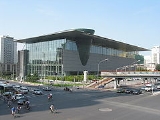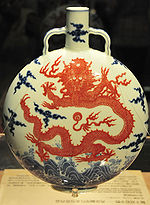
Capital Museum
Encyclopedia
The Capital Museum located at 16 Fuxingmenwai Dajie, Xicheng District
is an art museum in Beijing
, China
. It opened in 1981 while the present building was built in the late 1990s and it houses a variety of items from Imperial China
as well as other Asia
n cultures. Part of the museum's collections were formerly housed in the Confucius Temple on Guozijian Road in Beijing.
The Capital Museum was established in 1981 with a collection of some 83,000 objects. Although initially the Museum pales in comparison to the visitors received in other major art museums in Beijing, such as the Palace Museum in the Forbidden City, the National Museum of China
and the National Art Museum of China
; it has since then became one of the leading cultural institutions in the city, with the first five months of 2007 receiving more than 166,000 visitors.
The present Capital Museum's building's massive roof and the gradient at the entrance square was influenced by the design from ancient Chinese architecture
, and the stone-made exterior wall was meant to symbolize imagery of the city walls and towers in ancient China. A piece of danbi
(a massive stone carved with images of dragon, phoenix and imperial artifacts) is embedded on the ground in front of the north gate of the museum, whereas a decorative archway from the Ming Dynasty is set in the receptional hall in which shows the "central axis" feature that are commonly seen in Chinese architecture. The Bronze Exhibition Hall, which has an oval-shape, was also meant to symbolize the unearthing of ancient relics by its slanting design in which extends from the ground to the exterior of the museum.
 The exhibitions of fine artistic collections includes:
The exhibitions of fine artistic collections includes:
Xicheng District
Xicheng District is a district in Beijing, China. Xicheng District spans 32 square kilometres, making it the largest portion of the old city , and has 706,691 inhabitants . Its postal code is 100032. Xicheng is subdivided into 15 subdistricts of the city proper of Beijing...
is an art museum in Beijing
Beijing
Beijing , also known as Peking , is the capital of the People's Republic of China and one of the most populous cities in the world, with a population of 19,612,368 as of 2010. The city is the country's political, cultural, and educational center, and home to the headquarters for most of China's...
, China
China
Chinese civilization may refer to:* China for more general discussion of the country.* Chinese culture* Greater China, the transnational community of ethnic Chinese.* History of China* Sinosphere, the area historically affected by Chinese culture...
. It opened in 1981 while the present building was built in the late 1990s and it houses a variety of items from Imperial China
Imperial China
Imperial China may refer to:* Imperial era of Chinese history , divided into three major periods:** Early Imperial China** Mid-Imperial China** Late Imperial China...
as well as other Asia
Asia
Asia is the world's largest and most populous continent, located primarily in the eastern and northern hemispheres. It covers 8.7% of the Earth's total surface area and with approximately 3.879 billion people, it hosts 60% of the world's current human population...
n cultures. Part of the museum's collections were formerly housed in the Confucius Temple on Guozijian Road in Beijing.
Overview
The Beijing Capital Museum today contains over 200,000 cultural relics in its collection, only a small fraction of it are exhibited, and a significant percentage of the museum's art collection came from artifacts unearthed in Beijing.The Capital Museum was established in 1981 with a collection of some 83,000 objects. Although initially the Museum pales in comparison to the visitors received in other major art museums in Beijing, such as the Palace Museum in the Forbidden City, the National Museum of China
National Museum of China
The National Museum of China flanks the eastern side of Tiananmen Square in Beijing, China. The mission of the museum is to educate about the arts and history of China...
and the National Art Museum of China
National Art Museum of China
The National Art Museum of China, or NAMOC is located at 1 Wusi Ave, Dongcheng District of Beijing, People's Republic of China. It is one of the largest art museums in China. The construction of the museum started in 1958, and concluded in 1962. It has a total land area of 30,000 square meters...
; it has since then became one of the leading cultural institutions in the city, with the first five months of 2007 receiving more than 166,000 visitors.
The present Capital Museum's building's massive roof and the gradient at the entrance square was influenced by the design from ancient Chinese architecture
Chinese architecture
Chinese architecture refers to a style of architecture that has taken shape in East Asia over many centuries. The structural principles of Chinese architecture have remained largely unchanged, the main changes being only the decorative details...
, and the stone-made exterior wall was meant to symbolize imagery of the city walls and towers in ancient China. A piece of danbi
Bi (jade)
The bi is a form of circular jade artifact from ancient China. The earliest bi were produced in the Neolithic period, particularly by the Liangzhu culture . Later examples date mainly from the Shang, Zhou and Han dynasties. They were also made in glass.-Description:A bi is a flat jade disc with a...
(a massive stone carved with images of dragon, phoenix and imperial artifacts) is embedded on the ground in front of the north gate of the museum, whereas a decorative archway from the Ming Dynasty is set in the receptional hall in which shows the "central axis" feature that are commonly seen in Chinese architecture. The Bronze Exhibition Hall, which has an oval-shape, was also meant to symbolize the unearthing of ancient relics by its slanting design in which extends from the ground to the exterior of the museum.
Collections

- Collection of ancient ChinawarePorcelainPorcelain is a ceramic material made by heating raw materials, generally including clay in the form of kaolin, in a kiln to temperatures between and...
- Collection of ancient Beijing bronze art
- Collection of ancient calligraphyCalligraphyCalligraphy is a type of visual art. It is often called the art of fancy lettering . A contemporary definition of calligraphic practice is "the art of giving form to signs in an expressive, harmonious and skillful manner"...
- Collection of ancient paintingPaintingPainting is the practice of applying paint, pigment, color or other medium to a surface . The application of the medium is commonly applied to the base with a brush but other objects can be used. In art, the term painting describes both the act and the result of the action. However, painting is...
s - Collection of ancient jadeJadeJade is an ornamental stone.The term jade is applied to two different metamorphic rocks that are made up of different silicate minerals:...
ware - Collection of ancient sculptures and Buddhist statues
- Collection of gadgetGadgetA gadget is a small technological object that has a particular function, but is often thought of as a novelty. Gadgets are invariably considered to be more unusually or cleverly designed than normal technological objects at the time of their invention...
s of studies
External links
- Capital Museum website
- Capital Museum Gets Modern Look in Beijing This MonthBeijing This MonthBeijing This Month is a free monthly English language magazine, published in Beijing by the Beijing Foreign Cultural Exchanges Centre in association with the Beijing City Government.-Circulation:...

